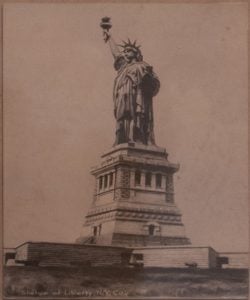Symbolism at the Opening
At the statue’s opening, the United States found itself embroiled in hundreds of labor strikes and protests, some deadly. Wealth inequality grew rapidly, and radicals protested exploitative labor policies. As unrest grew, notions of national liberty, equality and freedom seemed almost anachronistic.

Statue of Liberty post card, part of The City Reliquary Permanent Collection
Other groups who protested inequality, such as African-Americans and women’s suffrage groups, further viewed the project as a reminder of the freedoms they had been denied rather than an affirmation of a liberty that all Americans shared.
An African-American newspaper, The Cleveland Gazette, perhaps best summarized this feeling in an editorial published in November of 1886:
“ Shove the Bartholdi statue, torch and all, into the ocean until the same ‘liberty’ of this country is such as to make it possible for an industrious and inoffensive colored man in the south to earn a respectable living for himself and family, without being ku-kluxed, perhaps murdered, his daughter and wife outraged, and his property destroyed. The idea of the ‘liberty’ of this country ‘enlightening the world, or even Patagonia, is ridiculous in the extreme.”